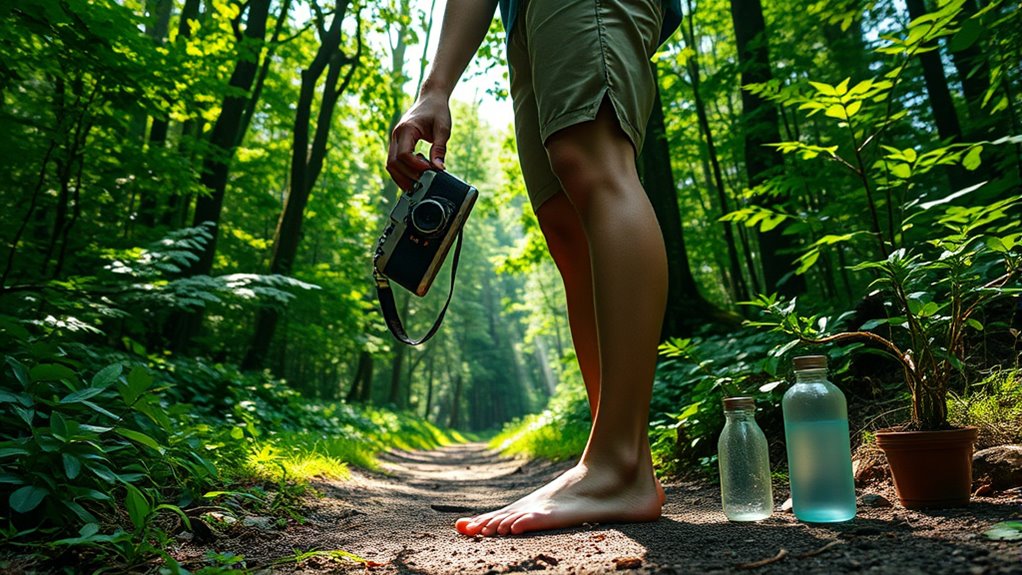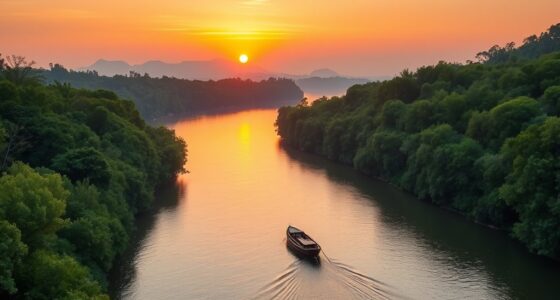To practice eco-friendly photography as a traveler, choose gear made from recycled or sustainable materials, and maintain your equipment to extend its lifespan. Respect wildlife and natural habitats by keeping your distance and staying on trails. Minimize waste by using reusable packaging and digital displays, and support local communities and conservation efforts. Opt for solar chargers and energy-efficient settings to reduce power use. If you want to learn more ways to capture stunning images responsibly, keep exploring these green photography tips.
Key Takeaways
- Use eco-friendly gear made from recycled materials and support brands committed to sustainability.
- Respect wildlife and habitats by maintaining safe distances and sticking to designated trails.
- Minimize waste with reusable packaging, digital displays, and careful planning to reduce unnecessary materials.
- Optimize camera settings and use solar-powered chargers to conserve energy during shoots.
- Promote sustainable techniques and gear through social media, tutorials, and responsible practices.
Choosing Sustainable Camera Gear and Accessories
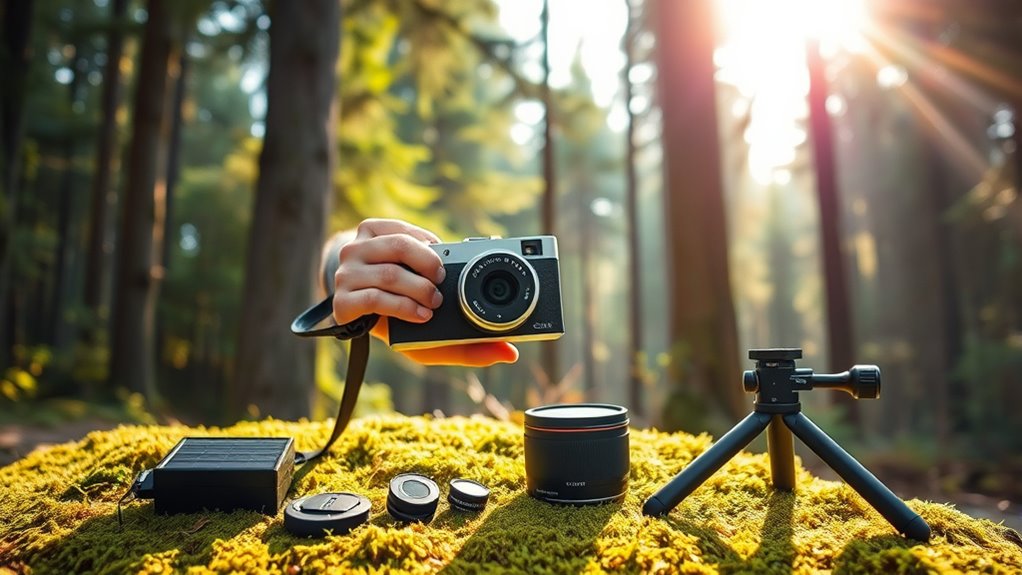
When selecting camera gear and accessories, you can make a significant environmental impact by prioritizing sustainable options. Look for products made from recycled materials, which reduce waste and lessen the demand for virgin resources. Many manufacturers now offer camera cases, straps, and accessories crafted from recycled plastics and fabrics, helping you minimize your footprint. Additionally, choose items that come in biodegradable packaging, which decomposes naturally and lessens landfill waste. By opting for eco-friendly packaging, you support companies committed to reducing environmental harm. These small choices add up, ensuring your photography gear aligns with your values of sustainability. Making conscious decisions about materials and packaging helps you enjoy your travels while contributing to a healthier planet. Regular maintenance, such as projector bulb maintenance, can also help extend the lifespan of your gear, reducing waste over time.
Respecting Natural Environments and Wildlife
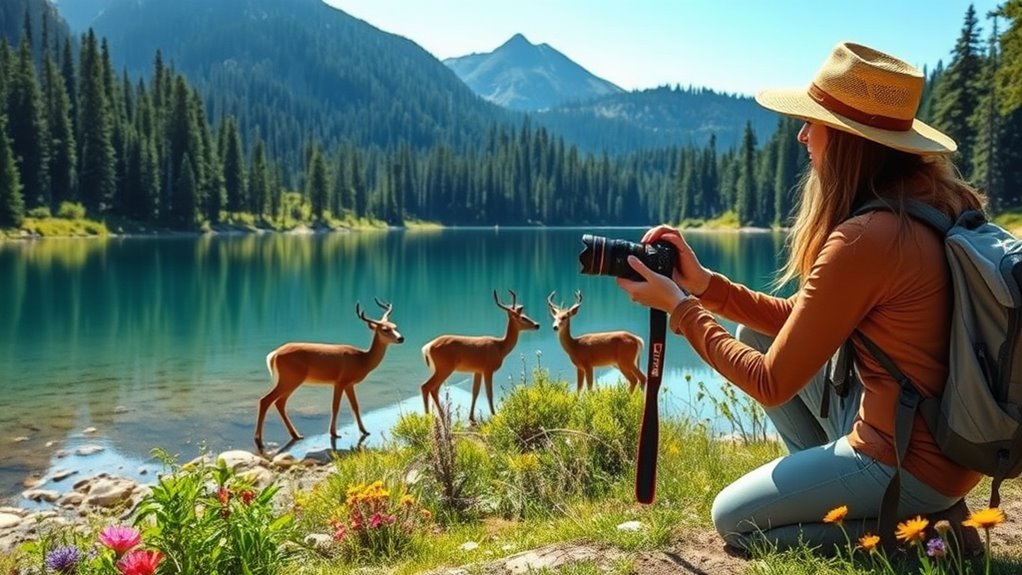
To truly capture the beauty of nature through your lens, you must also prioritize respecting the environments and wildlife you encounter. During wildlife observation, keep a safe distance to avoid disturbing animals or their habitats. Use binoculars or zoom lenses to get close-up shots without intruding. Stick to designated trails and avoid trampling vegetation, as this helps preserve habitats. Never feed or touch wild animals, as it can alter their natural behaviors and harm them. Respect signs and guidelines meant to protect sensitive areas. By practicing habitat preservation, you ensure that ecosystems remain healthy and resilient. Incorporating artistic elements into your photography can also enhance your images without disrupting the environment. Your mindful approach not only produces better photos but also supports the long-term well-being of the environment and its wildlife for future travelers.
Minimizing Waste and Packaging During Shoots

Minimizing waste and packaging during shoots is essential for reducing your environmental impact and supporting sustainability. Use reusable packaging whenever possible to transport and store your gear, avoiding single-use plastics and disposable containers. Opt for biodegradable materials for packaging and accessories, such as compostable wraps or biodegradable bags, which break down naturally and lessen landfill waste. Plan your shoots carefully to reduce unnecessary materials, and bring only what you need to avoid excess waste. Keep items organized to prevent damage and spills, reducing the need for additional packaging. By consciously choosing reusable and biodegradable options, you contribute to a cleaner environment and promote eco-friendly practices in photography. Incorporating proper waste management strategies can further enhance your efforts to minimize your footprint during every shoot. Small changes can make a significant difference in minimizing your footprint during every shoot.
Using Eco-Friendly Printing and Display Options

Building on your efforts to reduce waste during shoots, choosing eco-friendly printing and display options further lowers your environmental impact. Opt for eco-friendly paper made from recycled materials or sustainably sourced fibers to minimize deforestation. When printing, use sustainable ink, which is less toxic and biodegradable, reducing chemical runoff. Consider printing only what’s necessary and using digital displays when possible to cut down on paper use. If you need physical prints, select high-quality, durable options that last longer, reducing the need for reprints. Display your work in ways that promote reusability, such as framing with recycled materials or creating portable displays that can be reused across locations. Additionally, choosing electric bikes for transportation can reduce your carbon footprint during shoots, as electric bikes produce instant torque and can reach high speeds with minimal environmental impact. These choices support a more sustainable approach, helping you enjoy photography while respecting the environment.
Supporting Local Communities and Conservation Efforts

Have you considered how your photography can positively impact local communities and conservation efforts? Your actions can support sustainable development and preserve natural habitats. Here are four ways to do so:
Consider how your photography can support communities and conservation efforts through sustainable choices.
- Buy from local artisans to promote local craftsmanship and ensure that your purchases benefit the community directly.
- Participate in eco tourism initiatives that prioritize conservation and respect local customs.
- Share stories that highlight conservation efforts, raising awareness and encouraging others to get involved.
- Avoid exploiting wildlife or cultural sites, ensuring your photography doesn’t harm the environment or disrespect local traditions.
- Choose eco-friendly equipment and practices, such as energy-efficient gear and responsible waste disposal, which align with home theatre projectors technology standards to reduce environmental impact.
Practicing Responsible Tour and Workshop Selection
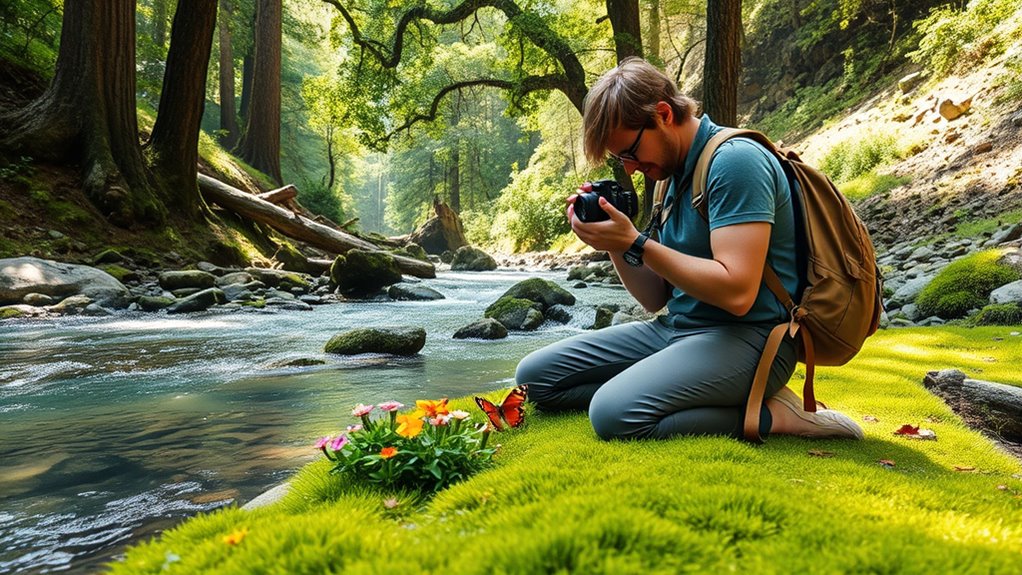
Choosing the right tours and workshops can substantially enhance your eco-friendly photography journey. Focus on providers that prioritize ethical travel, respecting local communities and environments. Look for operators committed to cultural sensitivity, guaranteeing they don’t exploit or disrespect local customs and traditions. Research reviews and ask questions about their sustainability practices, such as minimizing environmental impact and supporting local economies. Select tours that emphasize responsible behavior, like limiting disturbance to wildlife and avoiding damage to natural sites. By choosing thoughtfully, you help promote positive interactions between travelers and local populations. This approach not only enriches your experience but also ensures your photography efforts support conservation goals and foster mutual respect. Incorporating essential oils for environmental health and well-being can also support your overall eco-conscious lifestyle. Responsible tour selection is a crucial step toward truly eco-friendly and culturally sensitive photography.
Incorporating Leave No Trace Principles Into Photography
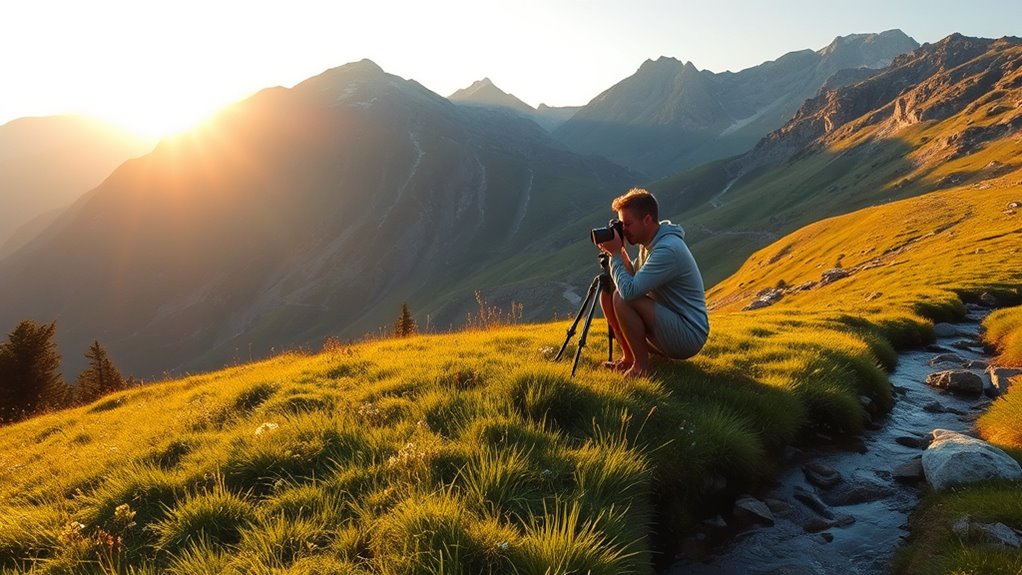
Incorporating Leave No Trace principles into your photography guarantees you leave natural sites as undisturbed as possible while capturing their beauty. To do this effectively:
- Stay on designated trails to avoid trampling sensitive vegetation and disturbing wildlife.
- Respect wildlife by maintaining a safe distance, especially during wildlife photography, to prevent stress or habitat disruption.
- Follow drone regulations strictly, ensuring your aerial shots don’t invade privacy or cause noise pollution.
- Pack out all trash and equipment to prevent litter and environmental impact.
Reducing Energy Consumption in Photography Equipment
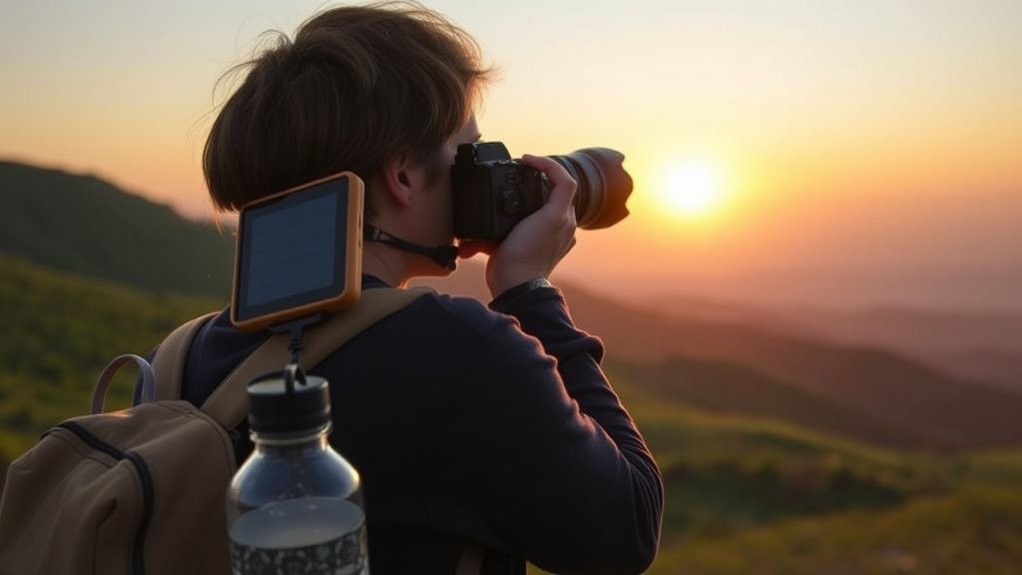
You can cut down on energy use by optimizing your device settings, like lowering screen brightness and turning off unnecessary features. Using solar chargers helps you recharge your equipment sustainably, especially when you’re outdoors. Small adjustments like these make a big difference in reducing your overall energy footprint. Being mindful of gaslighting tactics can also help prevent unnecessary emotional strain during your travels.
Optimize Device Settings
Optimizing device settings is a straightforward way to reduce energy consumption during photography sessions. By adjusting your camera settings, you can capture quality images while conserving battery life. Here are four tips to help you achieve this:
- Use the lowest acceptable resolution for your needs to minimize processing power and storage.
- Turn off preview displays or reduce their brightness to save energy.
- Enable image optimization features like auto ISO and HDR only when necessary.
- Set your camera to sleep mode when not actively shooting to prevent unnecessary power drain.
- Be aware of symptoms of equipment malfunction that could lead to increased power consumption or device failure.
Use Solar Chargers
Using solar chargers is an effective way to cut down on the environmental impact of your photography equipment. They harness solar power to provide portable energy, making it easy to keep your devices charged without relying on grid electricity. When you’re outdoors, solar chargers allow you to generate clean energy directly from the sun, reducing your carbon footprint. Harnessing solar energy makes it possible to power your devices sustainably, especially during extended trips. Compact and lightweight, they’re perfect for travelers who want an eco-friendly solution without added bulk. By using solar chargers, you guarantee your camera batteries and other electronics stay powered while minimizing environmental harm. This sustainable approach not only supports eco-friendly practices but also helps you stay prepared in remote locations. Embrace solar power and enjoy your photography adventures with a greener mindset.
Sharing and Promoting Eco-Conscious Photography Practices
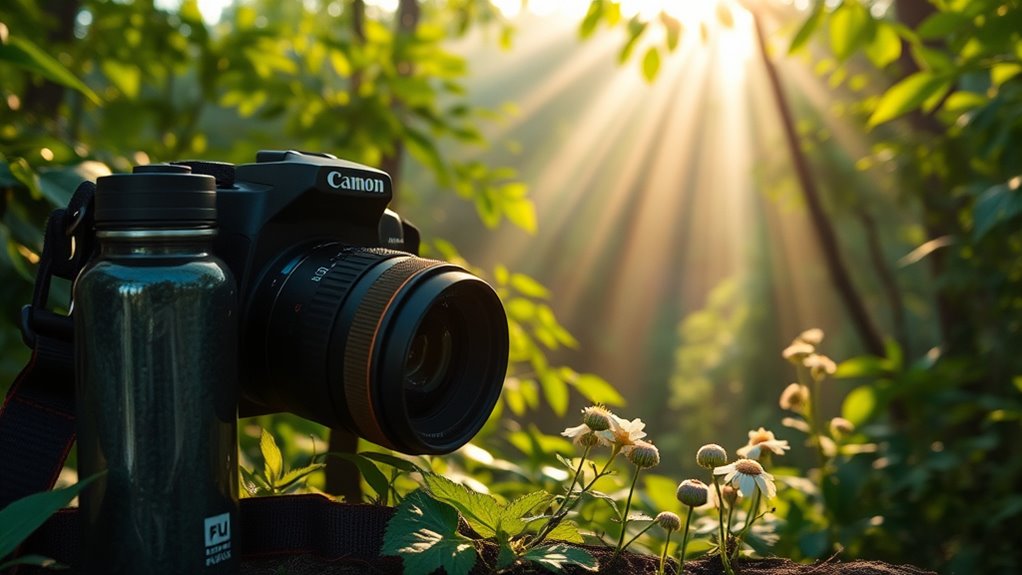
You can lead by showcasing sustainable techniques and sharing responsible practices with fellow photographers. Advocating for eco-friendly gear helps spread awareness and encourages others to make greener choices. Together, your efforts can inspire a broader shift toward more sustainable photography habits. Incorporating mindfulness and intentionality into your photography process, such as respecting natural environments and minimizing waste, further enhances your contribution to eco-conscious practices through mindful habits.
Showcase Sustainable Techniques
Sharing and promoting eco-conscious photography practices is essential for inspiring others to adopt sustainable techniques. You can showcase your efforts through social media, exhibitions, or blogs, highlighting eco-friendly choices. Use digital filters to enhance images without excessive editing, emphasizing natural beauty rather than over-processing. Incorporate color grading that respects the environment, avoiding exaggerated effects that distort reality. Here are some ways to showcase sustainable techniques:
- Share before-and-after images demonstrating minimal editing.
- Explain your use of digital filters to reduce post-processing.
- Highlight eco-friendly gear and techniques in your captions.
- Create tutorials showing how to achieve stunning results naturally.
Share Responsible Practices
Have you ever considered how promoting eco-conscious photography practices can influence others? Sharing your approach encourages fellow travelers to adopt sustainable habits. Use digital filters sparingly to enhance images without over-processing, emphasizing authenticity. When discussing your photos, highlight mindful image composition—like respecting wildlife or minimizing your footprint in natural settings. By showcasing eco-friendly techniques online or in person, you inspire a community that values conservation. Sharing stories about responsible practices helps spread awareness and encourages others to rethink their own habits. Remember, your influence extends beyond your photos; it can shape a culture of sustainability among travelers. Lead by example, demonstrating that beautiful images don’t have to come at the planet’s expense. Your responsible sharing can motivate positive change worldwide.
Advocate for Eco-Friendly Gear
By choosing eco-friendly photography gear, you can substantially reduce your environmental impact while capturing stunning images. Sharing your knowledge encourages others to adopt sustainable practices. Here are four ways to advocate for eco-conscious gear:
- Promote cameras with digital filters that reduce the need for post-processing, saving energy and resources.
- Highlight gear featuring advanced image stabilization, which minimizes the need for multiple shots and reduces waste.
- Advocate for products made from recycled or sustainable materials to support eco-friendly manufacturing.
- Share tips on maintaining gear properly to extend its lifespan and reduce electronic waste.
Frequently Asked Questions
How Can I Assess the Environmental Impact of My Photography Trips?
To assess the environmental impact of your photography trips, start by tracking your carbon footprint from transportation and equipment use. Be mindful of wildlife disturbance by maintaining a safe distance and avoiding flash photography. You can also research the environmental policies of your destinations and choose eco-friendly accommodations. Regularly reflect on your practices to minimize harm and guarantee your passion for photography doesn’t harm the environment or local ecosystems.
What Are Eco-Friendly Alternatives for Editing and Processing Photos?
You can choose eco-conscious software that minimizes energy consumption and reduces carbon footprints during photo editing. Look for digital filters that are designed to be energy-efficient and environmentally friendly. Opt for cloud-based editing tools to decrease hardware use and waste. By selecting eco-friendly software options, you actively reduce your environmental impact while creatively enhancing your photos. This thoughtful approach makes your photography process more sustainable and aligns with eco-conscious practices.
How Do I Educate Fellow Travelers About Sustainable Photography?
You can educate fellow travelers about sustainable photography by discussing photo ethics and encouraging mindful sharing. Share tips on respecting nature and local communities, avoiding intrusive shots, and minimizing equipment waste. Promote sustainable sharing by urging them to use eco-friendly platforms and reduce unnecessary image printing. Lead by example, and kindly explain how thoughtful photography benefits everyone’s experience and preserves the environment for future travelers.
Are There Specific Certifications for Eco-Conscious Photography Gear?
You might wonder if there are specific certifications for eco-conscious photography gear. Yes, eco labels and sustainable certifications exist to help you identify environmentally friendly equipment. Look for products with recognized eco labels like Energy Star or Forest Stewardship Council (FSC), which guarantee sustainable sourcing and energy efficiency. Choosing gear with these certifications supports eco-friendly practices and reduces your environmental impact, making your photography more sustainable.
How Can I Fund Conservation Projects Through My Photography Work?
You can fund conservation projects through your photography by exploring donation opportunities and charity collaborations. Share a portion of your earnings or sales proceeds with environmental organizations, or partner with charities that align with your values. Use your platform to raise awareness and encourage others to contribute. These efforts help protect natural habitats and wildlife, making your photography not just art but a catalyst for positive change.
Conclusion
By embracing eco-friendly photography practices, you become a steward of the environment rather than a visitor. Every shot you take can leave a positive mark, like footprints in the sand—visible yet gentle. Remember, your camera isn’t just a tool; it’s a catalyst for change. So, gear up with purpose, respect nature’s delicate balance, and let your images tell stories of preservation. After all, the world’s beauty is a gift—don’t let it become a memory you fail to protect.

